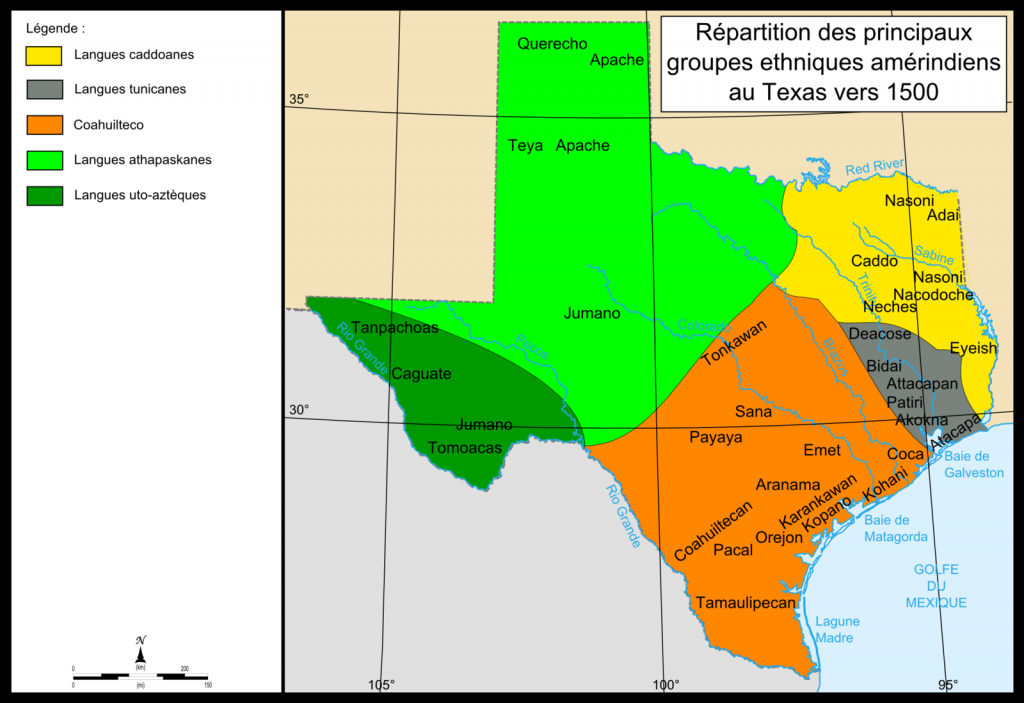Texas’s government, politics, and political culture are heavily influenced by our state’s unique history and the legends it inspired; thus, it helps to have a basic understanding of our history.
Six Flags Over Texas
Texas has been part of six different nations:

- Spain (1519–1821)
- France (1685–1690)
- Mexico (1821–1836)
- the Republic of Texas (1836–1845)
- the Confederate States of America (1861–1865)
- the United States of America (1845–1861; 1865–present)
Indigenous Tribes & European Colonization
Texas has been characterized by diversity since the beginning: several diverse and well-established indigenous tribes lived in Texas when European and French exploration of the area began.

French exploration and settlement in Texas under La Salle was brief and limited; however, French presence in the area did spur Spain to increase its presence in Texas, establishing a system of MISSIONS and PRESIDIOS.
Initially, Spain was resistant to immigration to Texas from the United States; however, this changed in the early 1800s. Following the negotiation of the ADAMS-ONIS TREATY in 1819, which more clearly defined the boundary between the U.S. and Mexico, Spain sought to develop a stronger presence in Texas and “buffer” against U.S. expansion through the recruitment of Anglo-American immigrants via land grants. This is where EMPRESARIOS come into play. The first of these were Moses Austin and his son, Stephen F. Austin. Moses was awarded a contract (fulfilled by his son following his death) to bring the original Anglo-American settlers to Texas (a total of 300 families).
Mexico
Under Mexican governance, the work of the empresarios continued, and by 1830, Anglo settlers made up a significant portion of the population in Texas. Although Mexico had hoped that the empresarios and new settlers would become loyal to Mexico, tensions rose, fueled by differences in political culture, the Mexican government’s insistence on Spanish as the official language and Catholicism as the official religion, and the issue of slavery. Some empresarios, including Austin, and Anglo settlers were loyal to the Mexican government; others were not. Haden Edwards led a group of Anglo settlers in Texas to secede from Mexico and establish the (short-lived) Republic of Fredonia near Nacogdoches in what is known as the FREDONIAN REBELLION. While this “rebellion” was not successful, it illustrates the rising tensions in Texas during this time period.
The Mexican government eventually modified laws to allow English as an official language, and made some other changes to accommodate the demands of the Anglo-American settlers; however, tensions remained. In 1829, the GUERRERO DECREE formally abolished slavery in all Mexican territories, including Texas. The following year, Mexico banned immigration from the U.S. Then, in 1833, SANTA ANNA, a CENTRALISTA, was elected president of Mexico. Santa Anna repealed the Federal Constitution of the United Mexican States of 1824 in favor of adopting a more unitary system of government in which power would be concentrated in the national government, with less local governing authority, which was not well received by many Tejanos and Texians.
The actions taken by Santa Anna eventually led to the TEXAS REVOLUTION, which began in 1835 at the Battle of Gonzales and lasted through May 14, 1836, when Santa Anna signed the TREATIES OF VELASCO recognizing Texas’s independence in exchange for his freedom.

Republic of Texas & Path to Statehood

The Republic of Texas was short-lived. Attempts at annexation were made immediately following Texas gaining independence from Mexico; however, the annexation of Texas was extremely controversial. In fact, it was one of the major issues at play in the 1844 election.
Prior to the 1844 election, President Tyler proposed the Tyler-Texas Treaty, which would annex Texas; ultimately, this treaty was defeated in the Senate (treaties require a 2/3 vote of approval in the Senate for ratification, which is a difficult threshold to meet). During the 1844 presidential election, one of the candidates, James K. Polk, framed Texas annexation through the lens of MANIFEST DESTINY, or the belief that U.S. expansion throughout the American continents was justified and inevitable. When Polk won the election, Tyler declared Polk’s victory a mandate for Texas annexation and called for the adoption of a joint resolution approved by a majority vote in House of Representatives and Senate (which is an easier threshold to meet than that required of treaties) to officially annex Texas. The annex resolution passed, and the Texas annexation convention passed the Tyler-Polk annexation offer on July 7, 1845.
Secession, Reconstruction, & Redemption
In 1861, Texans voted overwhelmingly in favor of secession, and Texas joined the Confederate States of America. Following the Civil War, Texas, like many other states, experienced PRESIDENTIAL RECONSTRUCTION and, later, RADICAL (or CONGRESSIONAL) RECONSTRUCTION. Radical reconstruction brought with it Republican dominance at the state level, ushered in partially as a result of newly enfranchised African American males and partially as a result of the DISQUALIFICATION CLAUSE of the 14th Amendment, which stripped voting rights from supporters of the Confederacy. After Reconstruction ended, confederate sympathizers began to regain the right to vote, black codes were enacted to make it more difficult for African American males to vote, and the state transitioned to one of Democratic dominance. These Democratic “Redeemers” set out to remove Republican influence from Texas government. “The rise of the Redeemers and the impact of THE GRANGE are especially important transitions in Texas politics because the constitution of this era remained in force long after the politics and politicians responsible for it had vanished” (Collier, Galatas, and Harrelson-Stephens, 2023, p. 15).
Twentieth-Century Transitions

The 20th century marked a time of change for Texas. One such change ushered in the new century: striking oil at SPINDLETOP in 1901. This not only transitioned Texas’s economy from one dominated by “King Cotton” to one dominated by oil (a change which ended up shaping state government and politics) but also marked the beginning of the oil age in the U.S.
In 1928, Texas voted for a Republican presidential candidate for the first time (Herbert Hoover). In 1961, Texas elected a Republican to serve in the U.S. Senate — the first Republican serving in a statewide office since Reconstruction. This marked the beginning of an era of PRESIDENTIAL REPUBLICANISM, with Texans voting for Republicans in national elections and Democrats in state and local elections. During the last two decades of the twentieth century, Republicans began to win local and state elections, and, by the late 1990s, the Republican party had come to dominate state politics in Texas.

One Reply to “Texas History, in a Nutshell”
Comments are closed.